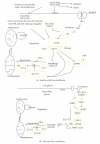Survival of exfoliated epithelial cells: a delicate balance between anoikis and apoptosis
- PMID: 22131811
- PMCID: PMC3205804
- DOI: 10.1155/2011/534139
Survival of exfoliated epithelial cells: a delicate balance between anoikis and apoptosis
Abstract
The recovery of exfoliated cells from biological fluids is a noninvasive technology which is in high demand in the field of translational research. Exfoliated epithelial cells can be isolated from several body fluids (i.e., breast milk, urines, and digestives fluids) as a cellular mixture (senescent, apoptotic, proliferative, or quiescent cells). The most intriguing are quiescent cells which can be used to derive primary cultures indicating that some phenotypes retain clonogenic potentials. Such exfoliated cells are believed to enter rapidly in anoikis after exfoliation. Anoikis can be considered as an autophagic state promoting epithelial cell survival after a timely loss of contact with extracellular matrix and cell neighbors. This paper presents current understanding of exfoliation along with the influence of methodology on the type of gastrointestinal epithelial cells isolated and, finally, speculates on the balance between anoikis and apoptosis to explain the survival of gastrointestinal epithelial cells in the environment.
Figures


Similar articles
-
Detachment-induced autophagy during anoikis and lumen formation in epithelial acini.Autophagy. 2008 Apr;4(3):351-3. doi: 10.4161/auto.5523. Epub 2008 Jan 7. Autophagy. 2008. PMID: 18196957
-
Induction of autophagy during extracellular matrix detachment promotes cell survival.Mol Biol Cell. 2008 Mar;19(3):797-806. doi: 10.1091/mbc.e07-10-1092. Epub 2007 Dec 19. Mol Biol Cell. 2008. PMID: 18094039 Free PMC article.
-
Apoptotic signaling during initiation of detachment-induced apoptosis ("anoikis") of primary human intestinal epithelial cells.Cell Growth Differ. 2001 Mar;12(3):147-55. Cell Growth Differ. 2001. PMID: 11306515
-
Bit1 in anoikis resistance and tumor metastasis.Cancer Lett. 2013 Jun 10;333(2):147-51. doi: 10.1016/j.canlet.2013.01.043. Epub 2013 Jan 31. Cancer Lett. 2013. PMID: 23376255 Free PMC article. Review.
-
[Control of the survival/apoptosis balance by E-cadherin: role in enterocyte anoikis].J Soc Biol. 2004;198(4):379-83. J Soc Biol. 2004. PMID: 15969344 Review. French.
Cited by
-
Mapping gastrointestinal gene expression patterns in wild primates and humans via fecal RNA-seq.BMC Genomics. 2019 Jun 14;20(1):493. doi: 10.1186/s12864-019-5813-z. BMC Genomics. 2019. PMID: 31200636 Free PMC article.
-
Assessing the Multivariate Relationship between the Human Infant Intestinal Exfoliated Cell Transcriptome (Exfoliome) and Microbiome in Response to Diet.Microorganisms. 2020 Dec 18;8(12):2032. doi: 10.3390/microorganisms8122032. Microorganisms. 2020. PMID: 33353204 Free PMC article.
-
Primary differentiated respiratory epithelial cells respond to apical measles virus infection by shedding multinucleated giant cells.Proc Natl Acad Sci U S A. 2021 Mar 16;118(11):e2013264118. doi: 10.1073/pnas.2013264118. Proc Natl Acad Sci U S A. 2021. PMID: 33836570 Free PMC article.
-
Intraepithelial lymphocytes are associated with epithelial injury in feline intestinal T-cell lymphoma.J Vet Med Sci. 2024 Jan 26;86(1):101-110. doi: 10.1292/jvms.23-0339. Epub 2023 Dec 8. J Vet Med Sci. 2024. PMID: 38072403 Free PMC article.
-
Exfoliated Kidney Cells from Urine for Early Diagnosis and Prognostication of CKD: The Way of the Future?Int J Mol Sci. 2022 Jul 9;23(14):7610. doi: 10.3390/ijms23147610. Int J Mol Sci. 2022. PMID: 35886957 Free PMC article. Review.
References
-
- Davis CD. Use of exfoliated cells from target tissues to predict responses to bioactive food components. Journal of Nutrition. 2003;133(6):1769–1772. - PubMed
-
- Kamra A, Kessie G, Chen JH, et al. Exfoliated colonic epithelial cells: surrogate targets for evaluation of bioactive food components in cancer prevention. Journal of Nutrition. 2005;135(11):2719–2722. - PubMed
-
- Kitazawa H, Nishihara T, Nambu T, et al. Intectin, a novel small intestine-specific glycosylphosphatidylinositol- anchored protein, accelerates apoptosis of intestinal epithelial cells. Journal of Biological Chemistry. 2004;279(41):42867–42874. - PubMed
-
- Kaeffer B, Des Robert C, Alexandre-Gouabau MC, et al. Recovery of exfoliated cells from the gastrointestinal tract of premature infants: a new tool to perform “noninvasive biopsies?”. Pediatric Research. 2007;62(5):564–569. - PubMed
-
- Aoyama F, Sawaguchi A, Ide S, Kitamura K, Suganuma T. Exfoliation of gastric pit-parietal cells into the gastric lumen associated with a stimulation of isolated rat gastric mucosa in vitro: a morphological study by the application of cryotechniques. Histochemistry and Cell Biology. 2008;129(6):785–793. - PubMed
Publication types
MeSH terms
LinkOut - more resources
Full Text Sources
Other Literature Sources
